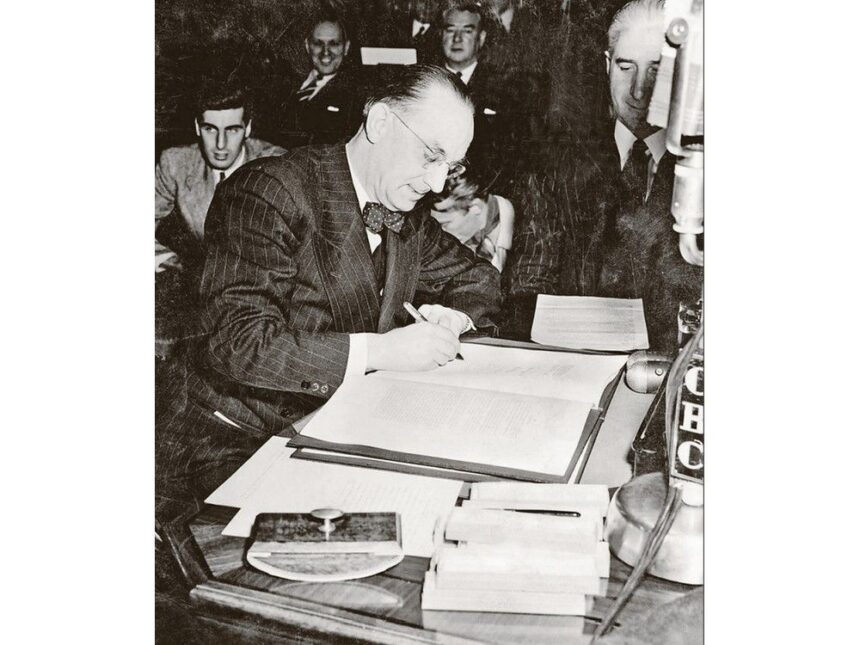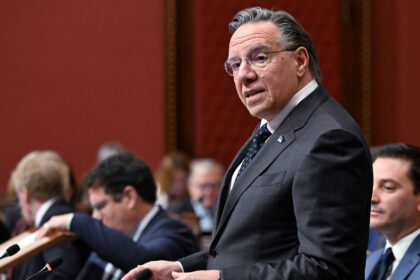In response to Bob Wakeham’s April 1 column, Patrick Hannaford points out what was happening in NL around the time of ConfederationPublished May 01, 2025 • 2 minute readJoseph R. Smallwood signs the Terms of Union between Canada and Newfoundland and Labrador in Ottawa on Dec. 11, 1948. — Photo courtesy of The Rooms provincial archives The RoomsIn his column of April 11, 2025, Mr. Wakeham asks, “What Have We Gone and Done?”This was in reference to the 75th anniversary of Newfoundland’s entering confederation with Canada.The referendum vote was not “incredibly close,” the ‘official’ result was 78,323 in favour and 71,334 opposed. Harold Horwood, who worked on the Confederate campaign, has written that when Prime Minister Mackenzie King expressed his wish that the majority had been wider, he was reminded by Jack Pickersgill that in the past 10 general elections King contested, there was only one where he received a larger share of the popular vote than that attained in the deciding Newfoundland referendum.THIS CONTENT IS RESERVED FOR SUBSCRIBERS ONLY.Subscribe now to access this story and more:Unlimited access to the website and appExclusive access to premium content, newsletters and podcastsFull access to the e-Edition app, an electronic replica of the print edition that you can share, download and comment onEnjoy insights and behind-the-scenes analysis from our award-winning journalistsSupport local journalists and the next generation of journalistsSUBSCRIBE TO UNLOCK MORE ARTICLES.Subscribe or sign in to your account to continue your reading experience.Unlimited access to the website and appExclusive access to premium content, newsletters and podcastsFull access to the e-Edition app, an electronic replica of the print edition that you can share, download and comment onEnjoy insights and behind-the-scenes analysis from our award-winning journalistsSupport local journalists and the next generation of journalistsRegister to unlock more articles.Create an account or sign in to continue your reading experience.Access additional stories every monthShare your thoughts and join the conversation in our commenting communityGet email updates from your favourite authorsSign In or Create an AccountorArticle contentHorwood, in his biography of Smallwood, has written that when Pickersgill informed King of this, he replied, “Is that so?”… “Well, that puts the matter in a different light, Pickersgill.”Had mercantile interests and religious institutions not thwarted the democratic process, the result for the ‘Yes’ side would have, undoubtedly, been higher.Wakeham brings up the old red herring about the promised return to responsible government prior to any vote. When Confederation was added to the referendum as one of the options, this condition became redundant.The anti-Confedrates, in-line with their undemocratic biases, fought to disallow this option on the ballot.Wakeham sees Newfoundland’s Responsible government as an independent authority that in 1934 “temporarily and (foolishly) relinquished…” its independence.The fact of the matter is, Newfoundland’s financial position was in dire straits and very close to financial collapse. This situation was mainly the result of a severe depression in international trade, resulting in significant declines in the value of Newfoundland’s exports. This situation was exacerbated by chronic political corruption and graft in successive Newfoundland political administrations.Article contentFrederick Alderdice, Newfoundland’s Prime Minister at the time, called on support from Britain to avoid defaulting on its debt. Alderdice, with legislative approval of the Newfoundland Assembly, signed off on surrendering Dominion status to allow an appointed commission to look after the affairs of Newfoundland.Contrary to how people in post-Confederation Newfoundland feel about this issue, there was very little opposition, either public or private, at the time; but given economic and political conditions in 1930s Newfoundland, it is not all that surprising.Wakeham would have us believe that Smallwood was “virtually hand-picked by the Canadians and the Brits to help bring about its desired goals.”Read More BOB WAKEHAM: ‘What have we gone and done?’ Looking back at Confederation and current political injustice 75 years since Confederation: A look into the lasting impact of N.L. joining Canada After the referendum, Britain wisely stayed out of the negotiations between Newfoundland and Canada to facilitate the transition of Newfoundland into the federation with Canada.In discussions and exchange of letters between Sir Albert Walsh, a native Newfoundlander and first lieutenant governor of the new province, and Canadian Prime Minster Mackenzie King, Mr. Smallwood was invited to assume the mantle of premier, very much the same as all provincial premiers.Mr. Wakeham vows to “continue on April 1st each year to ‘exploit’ this editorial space….. to deliver my ‘spin’ on Confederation……”‘Spin’ is one thing, and revisionist history and distortion of the facts is quite another.Patrick Hannaford St. John’sArticle content
LETTER: Don’t paint revisionist history around NL’s Confederation with Canada










